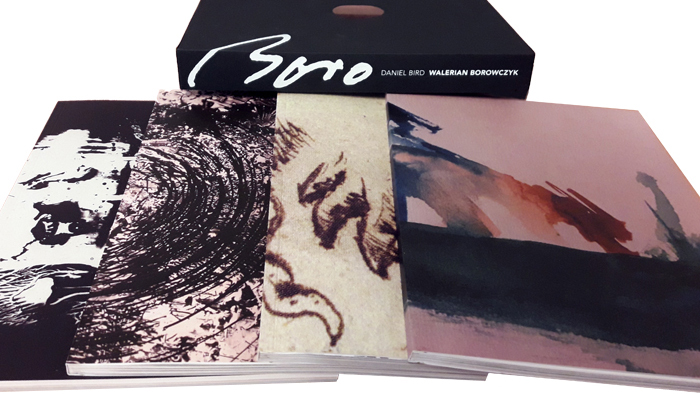RENAISSANCE: WALERIAN BOROWCZYK
SCREENING, BOOK LAUNCH & TALK WITH author DAniel Bird
DOORS 7PM FREE
Published to coincide with a major retrospective of painter, sculptor and filmmaker Walerian Borowczyk (1923 – 2006) at the Pompidou Centre in Paris, Boro: Walerian Borowczyk provides a comprehensive overview of a remarkable artist.
Painter, sculptor and filmmaker, Borowczyk, aka ‘Boro’, spent half a century working at the juncture of fine art and cinema. A true renaissance man, Borowczyk was not just a writer and director, but also a cameraman, editor, set designer and prop builder.
Born in Poland in 1923, Borowczyk trained as a painter before establishing himself as a poster artist. Along with with Jan Lenica, Borowczyk translated the graphic sensibility of the Polish poster into cinema. Together, Borowczyk and Lenica called for a new way of conceiving cinema, one which involved both fantasy and experiment. Inspired as much by the film experiments of Fernand Leger as the shorts of Méliès, Borowczyk and Lenica reminded the world that animation was for both adults and children.
In 1958, Borowczyk emigrated to France, where, after a brief collaboration with Chris Marker, he found employment making short films and commercials. With films such as Renaissance (1963) and Les jeux des anges (1964), he brought a cinematic dimension to assemblage and painting.
During the second half of the 1960s, he increasingly began to experiment with both animation and live action, as in his harrowing film of Guy de Maupassant’s short story, Rosalie Prudent, Rosalie (1966).
Having toiled on a feature length animated film, Théâtre de Monsieur & Madame Kabal (1967), Borowczyk made his remarkable live-action feature debut, Goto, l'île d'amour (1968).
Frequently characterised as an animator turned live-action filmmaker, Borowczyk himself drew no distinction between the two genres. If Borowczyk’s films have a defining characteristic, then it is the manner in which he framed action. In his eyes, objects are given as much significance as human subjects. This aspect of his cinema became more acute during the 1970s, when Borowczyk took advantage of relaxed censorship laws to explore sexuality on screen.
Inspired in part by the writer André Pieyre de Mandiargues, films such as Contes immoraux (1974) and La Bête (1975) focussed both on the rituals surrounding sex acts as well as how they transgressed cultural and societal norms. A surrealistic farce, La Bête brought to the fore the comic aspect of Borowczyk’s cinema.
Whether it is the visual gags in Le dictionnaire de Joachim (1965) or the bawdy or the earthy humour of Interno di un convento (1977), it is often forgotten that Borowczyk was a great comic filmmaker. If towards the end of his career Borowczyk found himself working in genre cinema, then he always subverted its conventions to his own ends, most notably in the outrageous Le cas etrange du Dr Jekyll et Miss Osbourne (1981).
The talk include screenings of a selection of Borowczyk’s short films, including Renaissance, Les jeux des anges, Rosalie and Diptyque.
ABOUT THE AUTHOR:
Daniel Bird first programmed Borowczyk’s short films at the National Museum of Photography, Film and Television (National Media Museum) in 1998.
Together with Ian White, Bird programmed a retrospective of Borowczyk’s films in 2001 at the Lux Centre. The following year, he received a Polish Government scholarship to study in Poland, where he filmed interviews many of Borowczyk’s Polish collaborators, including Szymon Bojko, Grażyna Długołęcka, Włodzimierz Kotoński, Stanisław Różewicz, Jan Tarasin and Andrzej Wajda.
In the year of Borowczyk’s death, Bird sought to re-establish Borowczyk as an artist-filmmaker by organising an homage at Aurora Festival involving the participation of Andrzej Klimowski, the Quay Brothers, Marcin Gizycki and Małgorzata Sady. In 2007 he worked with George Clark to include a new print of Borowczyk’s Les jeux des anges in the ‘Dreams’ touring programme organised by the Independent Cinema Office.
In 2009, he made a video essay on La Bête involving an encounter with the ‘beast’ in the Cinematheque Suisse and filmed interviews with several of Borowczyk’s collaborators for the UK DVD release of Goto, l'île d'amour. In 2011, Together with the German distributor Bildstörung, Bird reconstructed the original five-episode version of Contes immoraux.
From 2012, he led an international project to restore Borowczyk’s key shorts and features involving Arrow Films and restoration specialist James White. To mark what would have been Borowczyk’s 90th anniversary, Bird programmed a retrospective of restored copies of Borowczyk’s films at the 2013 edition of New Horizons Festival in Wroclaw. The same year, he organised a crowdfunding campaign to finance the restoration of Goto, l'île d'amour.
Together with Maggi Hurt, Bird programmed a retrospective of Borowczyk’s films at BFI Southbank and, with Juliette Desourges, curated the first UK exhibition of his sculptures and works on paper at the ICA, and presented an exhibition of Borowczyk's Polish posters at the Horse Hospital. Along with Michael Brooke, Bird co-produced Camera Obscura: The Walerian Borowczyk Collection, for Arrow Films, which was the recipient of the 2015 Focal International Prize for Best Restoration Project and a prize at Il Cinema Ritrovato.
In 2015, he produced a restoration of Le cas etrange du Dr Jekyll et Miss Osbourne which premiered in the Critics Week of Rotterdam Film Festival, and, together with Florence Almozini, programmed a retrospective of Borowczyk’s films at the Film Society of the Lincoln Center in New York.
Between 2015 and 2017 he worked with Fixafilm in Warsaw, Poland, to produce restorations of Borowczyk’s Polish films, including his short films and only Polish feature, Dzieje grzechu (Story of Sin). Between 2016 and 2017 he programmed retrospectives of Borowczyk in Bratislava and Sao Paulo and, together with Sylvie Pras and Eva Markovitz, at the Pompidou Centre.
Bird commissioned the first English translation of Borowczyk’s collection of short stories, L'anatomie du diable, guest edited a special Borowczyk edition of the Slovak Kino Ikon journal and assisted in the publication of Borowczyk’s only book for children, Les bêtes sont-elles bêtes ? Together with Michael Brooke, he authored Boro’s Dictionary (2014), which has been translated into Slovak, Portuguese and French
Together with Dominique Duvergé-Ségrétin and Abel Ségrétin, he is a co-founder of Friends of Walerian Borowczyk.

